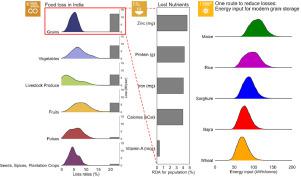Resources, Conservation and Recycling ( IF 11.2 ) Pub Date : 2020-08-14 , DOI: 10.1016/j.resconrec.2020.105100 Matthew F. Gibson , Narasimha D. Rao , Raphael B. Slade , Joana Portugal Pereira , Joeri Rogelj

|
Globally, India's population is amongst the most severely impacted by nutrient deficiency, yet millions of tonnes of food are lost along the supply chain before reaching consumers. Across food groups, grains represent the largest share of daily calories and overall losses by mass in India. This study quantifies energy input to minimise storage losses across India, responsible for up to a quarter of grain losses. In doing so, we explore links between three Sustainable Development Goals-SDG2, SDG7, and SDG12-, and provide insight for development of joined up agriculture and health policy in the country. Focusing on rice, wheat, maize, bajra, and sorghum, we quantify one route to reduce losses in supply chains, by modelling the energy input to maintain favourable climatic conditions in modern silo storage. We quantify key nutrients (calories, protein, zinc, iron, vitamin A) contained within these losses, and calculate roughly how much deficiency in these dietary components could be reduced if grain losses were eliminated. Our modelling indicates that maize has the highest energy input intensity for storage, at 110 (18) kWh per tonne of grain (kWh/t), and wheat the lowest, at 72 (14) kWh/t. This energy cost represents 8%-16% of the energy input required in grain production. We estimate if grain losses across the supply chain were saved and targeted to India's nutritionally deficient population, average protein deficiency could reduce by 46±4%, calorie by 27±2%, zinc by 26±2% and iron by 11±1%.
中文翻译:

能源在减轻印度粮食储藏损失中的作用及其对营养的影响
在全球范围内,印度人口受到营养缺乏症的影响最为严重,然而,数百万吨的食物在流向消费者之前在整个供应链上流失了。在所有食物类别中,谷物在印度的每日卡路里和总体质量损失中所占的比例最大。这项研究对能源输入进行了量化,以最大程度地减少整个印度的仓储损失,造成多达四分之一的粮食损失。在此过程中,我们探索了三个可持续发展目标(SDG2,SDG7和SDG12)之间的联系,并为该国联合农业和卫生政策的发展提供了见识。针对稻米,小麦,玉米,霸王和高粱,我们通过模拟能源输入以维持现代筒仓存储中有利的气候条件,量化了减少供应链损失的一种途径。我们量化关键营养素(卡路里,蛋白质,锌,铁,维生素A)包含在这些损失中,并粗略计算出如果消除谷物损失可以减少多少饮食成分的不足。我们的模型表明,玉米的存储能量输入强度最高,为每吨谷物(kWh / t)110(18)kWh,而小麦最低,为72(14)kWh / t。该能源成本占谷物生产所需能量输入的8%-16%。我们估计,如果挽救了整个供应链上的粮食损失,并针对印度营养不足的人口,平均蛋白质缺乏症可以减少46±4%,卡路里减少27±2%,锌减少26±2%,铁减少11±1% 。我们的模型表明,玉米的存储能量输入强度最高,为每吨谷物(kWh / t)110(18)kWh,而小麦最低,为72(14)kWh / t。该能源成本占谷物生产所需能量输入的8%-16%。我们估计,如果挽救了整个供应链上的粮食损失,并针对印度营养不足的人口,平均蛋白质缺乏症可以减少46±4%,卡路里减少27±2%,锌减少26±2%,铁减少11±1% 。我们的模型表明,玉米的存储能量输入强度最高,为每吨谷物(kWh / t)110(18)kWh,而小麦最低,为72(14)kWh / t。该能源成本占谷物生产所需能量输入的8%-16%。我们估计,如果挽救了整个供应链上的粮食损失,并针对印度营养不足的人口,平均蛋白质缺乏症可以减少46±4%,卡路里减少27±2%,锌减少26±2%,铁减少11±1% 。











































 京公网安备 11010802027423号
京公网安备 11010802027423号